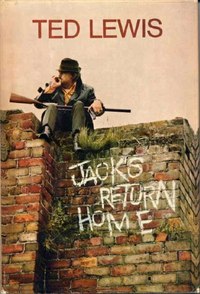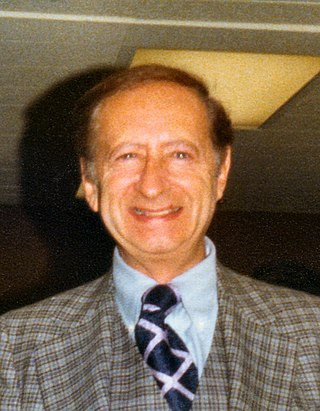
Robert Albert Bloch was an American fiction writer, primarily of crime, psychological horror and fantasy, much of which has been dramatized for radio, cinema and television. He also wrote a relatively small amount of science fiction. His writing career lasted 60 years, including more than 30 years in television and film. He began his professional writing career immediately after graduation from high school, aged 17. Best known as the writer of Psycho (1959), the basis for the film of the same name by Alfred Hitchcock, Bloch wrote hundreds of short stories and over 30 novels. He was a protégé of H. P. Lovecraft, who was the first to seriously encourage his talent. However, while he started emulating Lovecraft and his brand of cosmic horror, he later specialized in crime and horror stories working with a more psychological approach.
The Saint is the nickname of the fictional character Simon Templar, featured in a series of novels and short stories by Leslie Charteris published between 1928 and 1963. After that date other authors collaborated with Charteris on books until 1983; two additional works produced without Charteris's participation were published in 1997. The character has also been portrayed in The Saint franchise, which includes motion pictures, radio dramas, comic strips, comic books, and three television series.

The Hitchhiker's Guide to the Galaxy is a comedy science fiction franchise created by Douglas Adams. Originally a 1978 radio comedy broadcast on BBC Radio 4, it was later adapted to other formats, including novels, stage shows, comic books, a 1981 TV series, a 1984 text adventure game, and 2005 feature film.
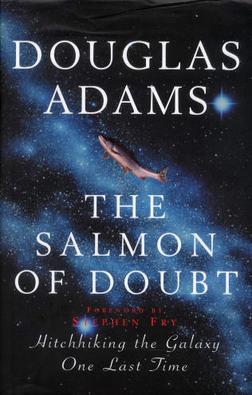
The Salmon of Doubt: Hitchhiking the Galaxy One Last Time is a posthumous collection of previously published and unpublished material by Douglas Adams. It consists largely of essays, interviews, and newspaper/magazine columns about technology and life experiences, but its major selling point is the inclusion of the incomplete novel on which Adams was working at the time of his death, The Salmon of Doubt. English editions of the book were published in the United States and UK on 11 May 2002, exactly one year after the author's death.

Trent's Last Case is a detective novel written by E. C. Bentley and first published in 1913. Despite the title, it is in fact the first work in which its central character, the artist and amateur detective Philip Trent, appears: he subsequently reappeared in the novel Trent's Own Case (1936), and the short-story collection Trent Intervenes (1938).

Get Carter is a 1971 British gangster film, written and directed by Mike Hodges in his directorial debut and starring Michael Caine, Ian Hendry, John Osborne, Britt Ekland and Bryan Mosley. Based on Ted Lewis's 1970 novel Jack's Return Home, the film follows the eponymous Jack Carter (Caine), a London gangster who returns to his hometown in North East England after his brother's death. Suspecting foul play, and with vengeance on his mind, he investigates and interrogates, regaining a feel for the city and its hardened-criminal element.
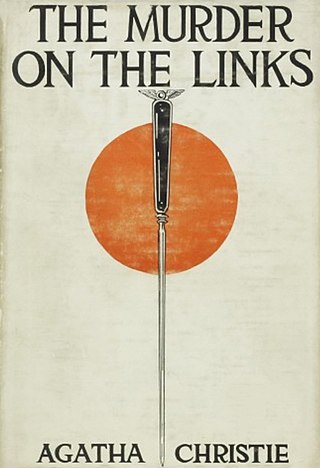
The Murder on the Links is a work of detective fiction by Agatha Christie, first published in the US by Dodd, Mead & Co in March 1923, and in the UK by The Bodley Head in May of the same year. It is the second novel featuring Hercule Poirot and Arthur Hastings. The UK edition retailed at seven shillings and sixpence (7/6), and the US edition at $1.75.

The Secret Adversary is the second published detective fiction novel by British writer Agatha Christie, first published in January 1922 in the United Kingdom by The Bodley Head and in the United States by Dodd, Mead and Company later in that same year. The UK edition retailed at seven shillings and sixpence (7/6) and the US edition at $1.75.

Death on the Nile is a work of detective fiction by British writer Agatha Christie, published in the UK by the Collins Crime Club on 1 November 1937 and in the US by Dodd, Mead and Company the following year. The UK edition retailed at seven shillings and sixpence (7/6) and the US edition at $2.00. The book features the Belgian detective Hercule Poirot. The action takes place in Egypt, mostly on the River Nile. The novel is unrelated to Christie's earlier (1933) short story of the same name, which featured Parker Pyne as the detective.

Elleston Trevor was a British novelist and playwright who wrote under several pseudonyms. Born Trevor Dudley-Smith, he eventually changed his name to Elleston Trevor. Trevor worked in many genres, but is principally remembered for his 1964 adventure story The Flight of the Phoenix, written as Elleston Trevor, and for a series of Cold War thrillers featuring the British secret agent Quiller, written under the pseudonym Adam Hall.

Absolute Beginners is a novel by Colin MacInnes, written and set in 1958 London, England. It was published in 1959. The novel is the second of MacInnes' London Trilogy, coming after City of Spades (1958) and before Mr. Love and Justice (1960). These novels are each self-contained, with no shared characters.

Murder in Mesopotamia is a work of detective fiction by British writer Agatha Christie, first published in the UK by the Collins Crime Club on 6 July 1936 and in the US by Dodd, Mead and Company later in the same year. The UK edition retailed at seven shillings and sixpence (7/6) and the US edition at $2.00. The cover was designed by Robin McCartney.

Ted Lewis was a British writer known for his crime fiction.
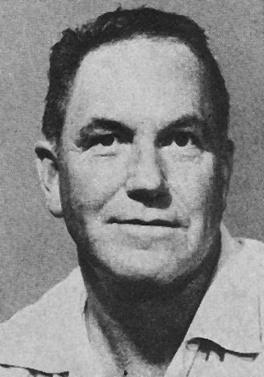
Charles K. Williams was an American author of crime fiction. He is regarded by some critics as one of the finest suspense novelists of the 1950s and 1960s. His 1951 debut, the paperback novel Hill Girl, sold more than a million copies. A dozen of his books have been adapted for movies, most popularly Dead Calm and The Hot Spot.
"The Veldt" is a science fiction short story by American author Ray Bradbury. Originally appearing as "The World the Children Made" in the September 23, 1950, issue of The Saturday Evening Post, it was republished under its current name in the 1951 anthology The Illustrated Man.
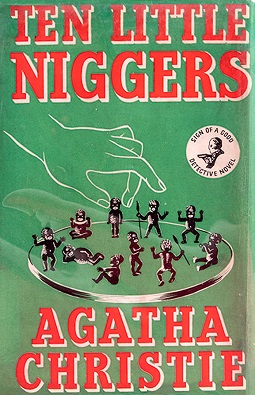
And Then There Were None is a mystery novel by the English writer Agatha Christie, who described it as the most difficult of her books to write. It was first published in the United Kingdom by the Collins Crime Club on 6 November 1939, as Ten Little Niggers, after an 1869 minstrel song that serves as a major plot element. The US edition was released in January 1940 with the title And Then There Were None, taken from the last five words of the song. Successive American reprints and adaptations use that title, though American Pocket Books paperbacks used the title Ten Little Indians between 1964 and 1986. UK editions continued to use the original title until 1985.

Alexander Baron was a British author and screenwriter. He is best known for his highly acclaimed novel about D-Day, From the City, from The Plough (1948), and his London novel The Lowlife (1963).
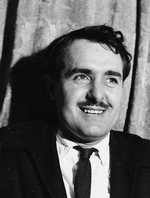
Gordon Holmes Landsborough, (1913–1983), English publisher, author and bookseller, was in the forefront of change in the paperback publishing and bookselling industries in England during the 1950s to 1980s. Considered a "maverick publishing genius", he was noted for his phenomenal drive and energy, his innovative business ideas and also for his prolific output as an author.

Jack Carter's Law is a 1974 British crime novel written by Ted Lewis. It is a prequel to Lewis' best known work, Jack's Return Home (1970) which was adapted into the film Get Carter in 1971. On Christmas Eve, Jack Carter learns that a supergrass is about to inform to the police and put him and his associates away for lengthy prison sentences. Carter attempts to hunt down the informer, but it proves a far more dangerous task than he anticipates.

Jack Oleck was an American novelist and comic book writer particularly known for his work in the horror genre.
